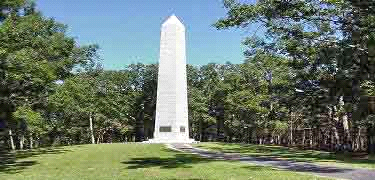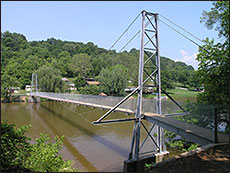1909 Changes
We remove a few of the 1909 0bleisk plaque list of patriot casualties because of overwhelming evidence. We change a few of the entries because of the preponderance of evidence for modification of the entry. We move rank from the roster of casualties to the individual virtual monument for each soldier. The positions filled on 17Oct1780 were not necessarily the formal rank by which each man was well known. Fluid militia organizations changed to meet the demands of the moment. At the moment of mid afternoon on 07Oct1780 each patriot was commissioned to be a colonel over his own actions. The patriot leaders told them that they knew what was needed and how to do it. They did not have to be told. Just “git er done.” We present our complete roster alphabetically instead of by categories so that a name may be readily found.
The 1909 plaque listed 24 unknown wounded men. We attempt to narrow the identity of the unnamed casualties with the names of the places or commanders where known.
Removed from the virtual plaque:
Beattie, David: Captain David Beattie was on the 1880 Kings Mountain monument as killed in action. After the battle, he filed a supplemental roster in Washington County for his soldiers for rations they supplied to the expedition. In 1783 he paid taxes on 4 horses and 10 cattle. He was a leader in the Liberty Hall/Ebbing Spring area. In 1909 he was not on the Kings Mountain monument plaque.
Patterson, Arthur: Private Arthur Patterson is listed as Killed in Action on the 1909 Kings Mountain monument. The Patterson heirs have his 1803 estate settlement over two decades later. The Patterson farm was just above the state line into North Carolina due north of the Kings Mountain battlefield. Oral family history is that Arthur Patterson Senior sent his sons out for chores about dinner time on 06Oct1780. They did not come back. The next day, 07Oct1780, Arthur went to investigate. He learned that Ferguson’s Tories had taken his cow and were holding his three sons as prisoners. He joined the Whigs that afternoon and was probably with the Lincoln County South Fork Boys at the battle. Among many other results, the patriots freed the three Patterson sons. Word spread that the Tories killed Arthur Patterson’s cow. British records corroborate that Ferguson appropriated crops and cattle, especially harshly from patriot farms.
—–Local reputation says that Arthur Patterson Junior became extremely vindictive after 07Oct1780 in dealing with Tories. He wanted to punish them all for killing his dad’s cow. They had deprived him of his butter and biscuits. In several counties it was common knowledge that the Tories killed Arthur Patterson’s cow at Kings Mountain. Along the way, cow was dropped from the line and the Feds posted Arthur Patterson killed at Kings Mountain.
—–Now faced with a different question, we choose to guess that Arthur Patterson was wounded in the battle.
Porter, James : The 1909 plaque lists Major James Porter wounded. Heitman states that Major Porter died 16Oct1780 from wounds received at Kings Mountain, but the plaque does not say mortally wounded. Draper states that Major Porter moved to Greeneville SC and lived many years. Despite Heitman and Draper, if either William Porter or James Porter were majors, we would expect at least one pensioner to name Major Porter as a commander, but none did. 10Jan1816, Captain Richard Graham deposed in Iredell County NC that Sergeant James Porter was wounded at Ramsour’s Mill. FPA file S25370 contains other testimony from Porter and surgeons regarding his wound and disability after June 1780. It appears that no Porter entry at Kings Mountain is appropriate. Instead an accurate monument entry at Ramsour’s Mill in Lincolnton should state Sergeant James Porter wounded.
Smith, JM: !st Lt JM Smith on the plaque appears to be a typo. Neither Lyman Draper nor Bobby Moss mention such a name. Conspicuously absent from the 1909 monument is Lieutenant James Martin Lewis, brother of Joel and Micajah from Surry County under Colonel Benjamin Cleveland. Samuel Newell named James M Lewis under the care of Dr. Dobson at Mr. Mackey’s house on the Catawba.
Steen, James: Lt Col James Steen was not on the 1880 monument but was added to the 1909 monument as killed. The 2012 South Carolina General Assembly dedicated the James Steen Bridge. In their resolution, they stated that Steen was stabbed in Rowan County in 1781. Without a single mention from hundreds of Kings Mountain soldiers, it is unlikely that a colonel was in the battle, but that inconspicuous. A good guess is that he was with Sumter’s remnant or traveling between Cowpens and Salisbury on 07Oct1780.
Entries changed from the 1909 list in this new list:
Bowen, Rees: So many spelled this giant of a man’s name Reece or Reese. He was actually named for his mother’s maiden name Rees. One of the Maiden Fort men from Tazewell County Virginia area, Lt Rees Bowen took command in behalf of his brother William who was sick and unable to command the company for the Kings Mountain expedition. Huge men like Bowen and Colonel Benjamin Cleveland were dwarfed by some near seven footers among the Patriots such as Joseph Greer and Salathiel Martin. When the rumors reached Cornwallis in Charlotte, there were thousands of vicious deranged giants. By stature, Bowen, though killed in action, might have contributed to Cornwallis’ withdrawal toward Charleston.
Bullen, Philip: Though listed as William Bullen by Lyman Draper in Kings Mountain and its Heroes, Draper’s source, Gov Campbell’s letter from Samuel Newell clearly named Philip Bullen.
Curry, James: Listed as Private James Corry by Lyman Draper in Kings Mountain and its Heroes, James was known to widow Mary Curry and the folks around Black’s Fort as Sgt. James Curry. When James Curry Jr. reached legal age, Washington County deeded his deceased dad’s farm to him.
Gilleland, John: (aka Gilliland) The 1909 plaque lists a Private Gilleland with a blank first name. Kay White wrote that John Gilleland was a Kings Mountain wounded pensioner living at the mouth of the Pigeon River. On her word, we can fill in the blank. Confirming Kay’s entry is another matter. The federal pension archives have no file for him.
Gist, Richard: Listed as Ensign Nathaniel Gist by Lyman Draper in Kings Mountain and its Heroes, Draper’s source, Gov Campbell’s letter from Samuel Newell clearly named Private Richard Gist. The plaque shows 2nd Lt Nathaniel Gist. The Virginia militia had no rank of second lieutenant. That was a continental army designation. But it becomes a non-issue on the casualty plaque since rank is moved to the individual soldier plaques. The alphabetic casualty plaque has nothing but heroes regardless of status.
Henigar, Henry: Misspelled by many, including Samuel Newell, we list Henry’s last name as spelled by long time Washington County clerk and Samuel Newell friend, Andrew Russell, also a BKM vet.
Hice, Leonard : Misspelled by many, including Samuel Newell, we list Leonard’s last name as spelled by long time Washington County clerk and Samuel Newell friend, Andrew Russell, also a BKM vet. Newell did not misspell Israel Hayter. Hayter’s Gap was well known and continues as the name of the USGS Topo Quadrangle adjacent north of Abingdon.
Lewis, James Martin: We replace !st Lt JM Smith on the plaque with James Martin Lewis. It appears that JM Lewis, a well documented soldier at Kings Mountain, was the original intent for the plaque, but was mistakenly changed from Lewis to Smith during inscription.
McCulloch, Thomas : Many descendants of the Abingdon McCulloch’s spell their names McCullough. Several clerks spelled the name phonetically as McCullock. We leave the spelling as the dominant version, McCulloch.
download the Newell letter transcription
Samuel Newell’s 1823 letter to Virginia Governor (prior governor by the time of the letter) David Campbell. The manuscript is a copy, not Newell’s handwriting, so we show the transcribed manuscript which gives some details of the officers and casualties of the Virginians at Kings Mountain.








